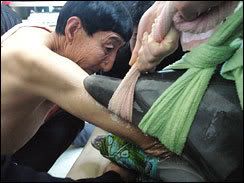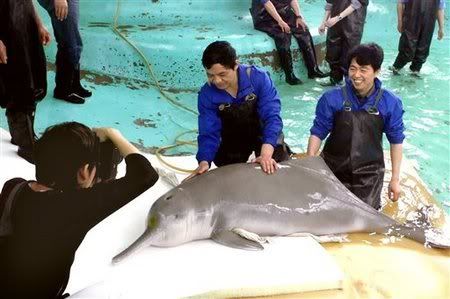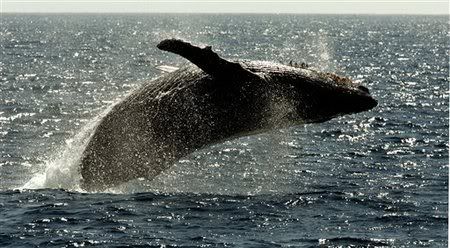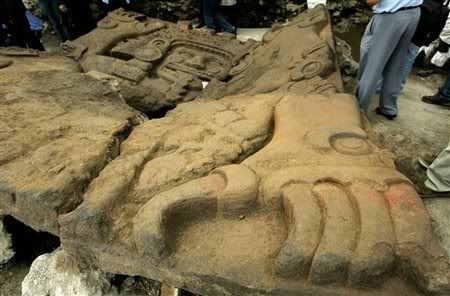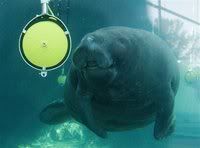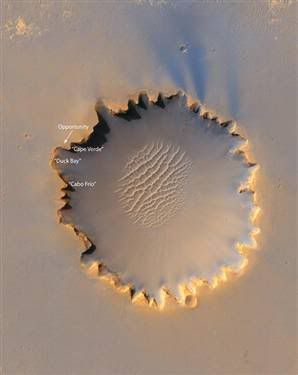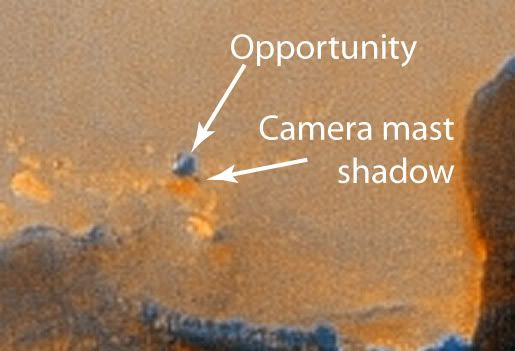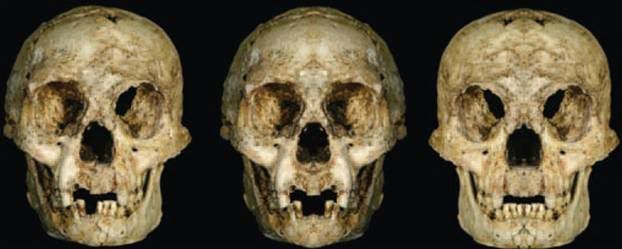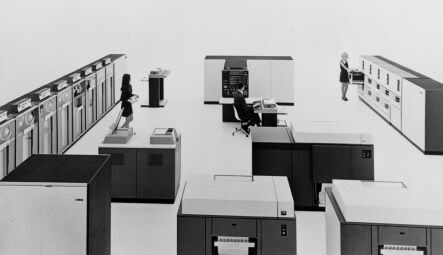"It was a science fiction fantasy come true: Ten years ago this summer, NASA announced the discovery of life on Mars.
At a Washington, D.C., news conference, scientists showed magnified pictures of a four-pound Martian meteorite riddled with wormy blobs that looked like bacterial colonies. The researchers explained how they had pried numerous clues from the rock, all strongly supporting their contention that microscopic creatures once occupied its nooks and crannies.
It was arguably the space agency's most imagination-gripping moment since Apollo. Space buffs and NASA officials said that it just might be the scientific discovery of the century.
'If the results are verified,' the late Carl Sagan pronounced, 'it is a turning point in human history.'

Ten years later, the results have not been verified. Skeptics have found non-biological explanations for every piece of evidence that was presented on Aug. 6, 1996. And though they still vigorously defend their claim, the NASA scientists who advanced it now stand alone in their belief.
"We certainly have not convinced the community, and that's been a little bit disappointing," said David McKay, a NASA biochemist and leader of the team that started the scientific episode.
But even though the majority of his colleagues don't buy his "life on Mars" theory - McKay's own brother, also a NASA scientist, is one of his most prominent critics - many say they respect him and greatly appreciate his efforts.
The announcement and the technical paper that followed it practically created exobiology, the scientific field that investigates the potential for life on other planets.
"Without that paper I wouldn't be working in this field," said Martin Fisk, a marine geologist who studies how bacteria survive under the sea floor, partly because their harsh environment may resemble that of extraterrestrial life.
Debating the claim has helped researchers develop standards that will eventually prove useful for evaluating the presence of life in other Martian meteorites or a sample from the red planet. It has given the scientific community ideas about exactly where on the planet they would most like to scoop up a sample, should they ever get to retrieve one.
And it is undeniable that McKay and his colleagues have drawn attention to what is - whether it contains evidence of life or not - a very interesting rock.
The rock in question was discovered in Antarctica, where rocks that fall from the heavens are easy to spot on the icy glacial plains. Its name, ALH84001, indicates that it was the first meteorite found during the 1984 research season in the Allan Hills, an especially meteorite-rich area in the Trans-Antarctic Mountains.
At first ALH84001 was misclassified, so it wasn't until 1993 that researchers even realized the rock came from Mars. That was interesting enough, because at the time fewer than a dozen Martian meteorites were known to science.
But ALH84001 also turned out to be much more ancient than the other known Martian meteorites. At 4.5 billion years old, it dates from a period of Martian history when liquid water - a requirement for the presence of life - probably existed at the now barren planet's surface.
It made sense to ask: Could there be fossils of ancient Martian microbes, or maybe traces of them, preserved in the cracks and pore spaces of ALH84001?
The NASA scientists proffered four reasons to support their view that the answer to that question is "Yes."
First, chemical analysis showed that the meteorite contained a variety of organic molecules known as polycyclic aromatic hydrocarbons, or PAHs. PAHs can be produced by biological processes, and that's what McKay and his colleagues argued. But they are also commonly found in asteroids, comets and meteorites, not to mention the Antarctic ice where ALH84001 is estimated to have lain for 13,000 years. For that reason, skeptics immediately dismissed the importance of PAHs in the Martian meteorite.
A second line of evidence - that the elongated blobs in the electron microscope images could be fossils of ancient Martian bacteria - was also rejected pretty quickly by most scientists.

The problem was, those blobs were much smaller than any bacteria that have ever been observed on Earth. A National Research Council panel concluded in 1998 that the blobs were 100 to 1,000 times too small to be free-living organisms because they couldn't have held all the proteins, DNA and other molecules necessary for even the simplest metabolic processes.
You could argue that perhaps Martian life evolved a more compact biochemistry, or that the blobs shriveled as they fossilized. At one point McKay and the other NASA scientists suggested the blobs might be pieces of larger organisms.
"That was only mentioned once or twice and never brought up again," said Allan Treiman, a geologist at the Lunar and Planetary Institute in Houston.
The two other lines of evidence survived longer. Both revolved around minerals sprinkled through the meteorite that could have been produced by microbes.
The first mineral, carbonate, is typically formed on earth by the remains of living organisms that make shells and other skeletal parts out of minerals they extract from seawater. Some of those organisms can be quite tiny. So finding carbonate in ALH84001 could indicate the presence of ancient microbes in the rock.
The story is similar for magnetite, the other mineral of interest in ALH84001. Some bacteria produce extraordinarily small and pure magnetite crystals, then align the magnetic grains to make a microscopic compass needle that helps them navigate.
The bacteria don't use their internal compasses to find north; they use them to tell up from down. Earth's spherical shape means that a compass needle in either hemisphere points at least somewhat downward, so the magnetite grains help the microbes sense where they are with respect to the planet's surface.
Some of the most evolutionarily ancient bacteria on Earth produce magnetite, McKay and his colleagues pointed out. Perhaps ancient Martian microbes did as well; at least some of the magnetite grains in ALH84001 share the shape, small size and remarkable purity of those produced by bacteria on Earth.
Of all the lines of evidence presented by the NASA scientists, it was the magnetite grains that proved most provocative. They were embedded in the carbonate along with other iron-containing minerals in such an unusual arrangement that something out of the ordinary must have put them there - could it have been alive?
"The shape of the magnetite grains is still rather distinctive," McKay said. "If it were found on Earth it would be a very strong biosignature."
For years McKay and his detractors argued about how distinctive the magnetite grains in ALH84001 are, and whether a non-biological process could have produced them. Certainly nobody had ever produced similar magnetite grains in the laboratory.
Then somebody did. In 2001 a second team of NASA scientists, including McKay's brother Gordon and a consultant to the space agency named D.C. Golden, managed to cook up a batch of magnetite grains very similar to the ones in ALH84001. Golden and Gordon McKay were also able to incorporate the magnetite grains into balls of carbonate like the ones David McKay and his colleagues described in 1996.
"He got a little testy about the results we were getting," said Gordon McKay, whose office is down the hall from his brother's. "What we have shown is that it is possible to form these things inorganically."
What's more, their laboratory method simulated conditions ALH84001 is known to have experienced during its time on Mars.
Yet David McKay insists his brother's team has not accurately described the synthetic crystals' shape, and that they aren't sufficiently similar to the ones found in ALH84001. He also suggests that the purity of the magnetite crystals stems not from the lab process itself, but from using unrealistically pure raw materials as a starting point.
Most of the scientific community doesn't buy those arguments.
"Personally I don't understand why (Gordon McKay's and) Golden's work hasn't just been the final word on it," said Treiman, the Lunar and Planetary Institute geologist.
Now David McKay has added another meteorite to the mix. At a March scientific meeting he presented microscopic images of the Nakhla meteorite, another Martian specimen. The pictures resemble pits that terrestrial bacteria create as they literally eat the volcanic rock of the sea floor.
"When I first saw it I was really struck by the similarity," said marine geologist Fisk, who is a professor at Oregon State University.
So far the scientific community hasn't shown much interest in David McKay's analysis of the Nakhla meteorite, partly because it dates from a more recent period of Martian history when the planet was just as frigid and inhospitable to life as it is today. In fact all of the 30-some Martian meteorites now known to science, with the exception of ALH84001, are probably too young to have contained living organisms.
But new Martian meteorites turn up almost every year. Eventually, another 4.5 billion-year-old piece of the red planet is going to be discovered.
"Sooner or later we're going to get another old rock," said Massachusetts Institute of Technology geophysicist Benjamin Weiss.
And when that happens, the talk about life on Mars will begin anew."




